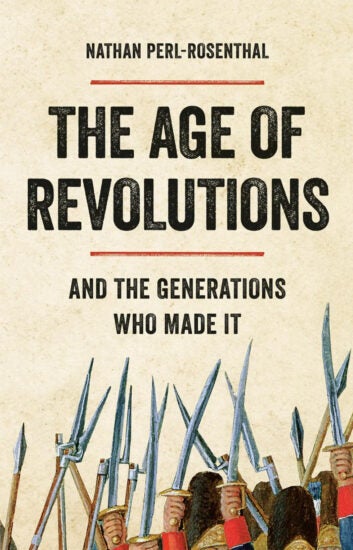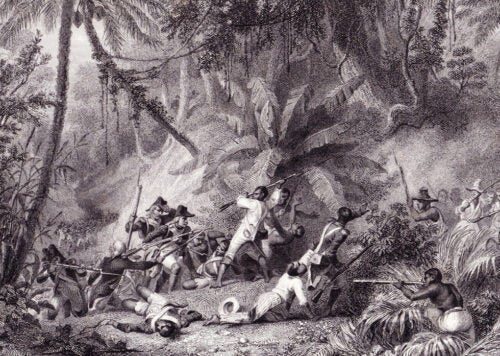
How the American quest for independence fueled a worldwide movement
On July 4, Americans pull out the picnic blankets and blast off fireworks to celebrate the Declaration of Independence and the creation of the United States as a sovereign nation.
The American Revolution was the first in a series of political upheavals around the globe, from the late eighteenth century through the middle of the nineteenth, which shook monarchies and empires around the globe and began to replace them with representative governments.

This tumultuous era is the subject of a new book, The Age of Revolutions: And the Generations Who Made It (Basic Books, 2024) by Nathan Perl-Rosenthal, professor of history, French and Italian and law at the USC Dornsife College of Letters, Arts and Sciences.
He says it’s long been a topic of personal fascination for him, particularly because it brought forth the cultural and political underpinnings of the world we still live in today.
“When John Adams was born in 1735, he came into a world very different from our own. The world in which he died in 1826, looks much more familiar to us,” says Perl-Rosenthal. “The revolutionary era, which his long life covered, was the origin point for most of what we know as modern politics.”
Perl-Rosenthal answered questions about the era–and the American Revolution in particular.
Why did this era have so many revolutions?
There are two ways to explain why this happened. And they’re not opposed; they’re actually convergent. The more familiar story is that they came out of the Enlightenment, an eighteenth-century intellectual movement founded on the idea that human beings are fundamentally similar and equal. That idea of equality posed a growing challenge to all sorts of political hierarchies.
The other story, a bit less well known, is that the revolutions emerged from inequality. The eighteenth century was an era of considerable economic growth, but enormously unevenly distributed. You can see this very clearly on the island of Saint-Domingue, then a French colony now the nation of Haiti, which became a center of revolutionary politics in the 1790s.

At the beginning of the century, this French colony has a population of about 20,000 people, and produced relatively small amounts of sugar and indigo. Over the next 80 years, the population grew to over 500,000, of whom 90% are enslaved, and became the single most productive agricultural colony in the world. It provided sugar and coffee to all of Europe. This enormous economic engine was built on radical inequality.
That was the heart of eighteenth-century economies–inequality. And that was true even in places that we think of as being more equal, like Boston, which actually had an incredibly stratified society.
It turns out these societies, very unequal societies, are fragile. The people who are stuck in positions lower down in the hierarchy don’t like it, especially when they’re imbibing Enlightenment ideas about natural equality.
So, I think one of the motors for this series of revolutionary movements was a sense that “we’ve got to shatter this unequal society we’re stuck in.”
In a recent Atlantic article, you argued that revolutions are “generational.” Could you explain what you mean?
People were pushing this idea of natural equality and trying to build mass political movements. But when you’re in your 40s, as John Adams and Thomas Jefferson were at the time of the American Revolution, it’s really difficult to come to grips with the fact that you’re not in charge of things anymore and you might need to get the agreement of a large group of people to make changes.
You might find that even though you believe in the principle of equality of all people, you still want to hold people in slavery, as Jefferson did. Or you might still get upset, as John Adams certainly did, when farmers in western Massachusetts want a say in politics.
In the first wave of revolutions, ordinary people and elites tried hard to build political movements. But in practice they just could not hold them together for very long.
It was only after 1800, when a second generation came of age, conditioned to a different set of social norms, that one really starts to see enduring mass political movements taking shape across lines of class and race. And these new mass movements were able to push a lot further than previous generations had been.
What elements of the American Revolution do you think people aren’t aware of?
One part of the story that is not very present in high school or college curriculums is a recognition of how much of the Revolution was driven by fear.
My favorite example of this might be the Tea Act of 1773, which led to the famous Boston Tea Party.

Most people think that the act raised the price of tea. It was actually the reverse.
North Americans were drinking illegally imported Dutch tea, which was cheaper because it wasn’t taxed. The British lowered taxes to make the legal tea more affordable.
To the leaders of the American colonies, this was an outrage: “If we let them lower the taxes on this, then we might get hooked on tea and, later on, they might raise them again!” It’s a very fearful, one might almost say paranoid way of thinking.
That’s a kind of leitmotif that runs through a lot of the early American Revolution. You don’t see it when you read documents like Common Sense or the Declaration of Independence because they’re very brassy and assertive. But a lot of that self-confident rhetoric was covering up a real sense of vulnerability.
The American Revolution is generally considered the first in this era. Did it inspire subsequent revolts?
David Armitage wrote a great book called The Declaration of Independence: A Global History (Harvard University Press, 2008) that shows just how influential the Declaration of Independence was on a worldwide scale. There was also a strong American influence on certain kinds of constitutionalism: the Mexican Constitution owes a pretty big debt to the U.S. Constitution.
Maybe more important than the ideological echoes were some very specific, concrete ripple effects. One of the main causes of the French Revolution was the gigantic debt that France took on to help pay for the American Revolution, which destabilized the monarchy.
Brian Delay, a historian at the University of California, Berkeley, has shown that American-made guns and gunpowder made possible the wars of Spanish-American independence, not to mention the Haitian revolution.
Can you recommend other books or films about the American Revolution?
I’d say that David Waldstreicher is the most creative and versatile living historian of the American Revolution. He has a new book out now on Phyllis Wheatley, an enslaved woman and poet who lived through the American Revolution.
The John Adams miniseries on HBO is good, too. It’s especially accurate in its depictions of the physicality of this era. For instance, George Washington really was a head-and-a-half taller than most everyone else in the room, which gave him this very commanding presence as a leader.